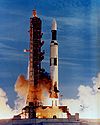Wikipedia:Today's featured article/December 10, 2004
The Saturn V was a multistage liquid-fuel expendable rocket used by NASA's Apollo and Skylab programs. It was the largest production model of the Saturn family of rockets, although larger models were theorised. The rocket was designed under the direction of Wernher von Braun and Arthur Rudolph at the Marshall Space Flight Center, with the lead contractors being The Boeing Company, North American Aviation, Douglas Aircraft Company and IBM. Thirteen Saturn V rockets were launched from 1967 to 1973, with a perfect launch record. (Although Apollo 6 and Apollo 13 did lose engines, the onboard computers were able to compensate.) The main payloads of the rocket were the Apollo spacecraft which carried the NASA astronauts to the Moon. It also launched the Skylab space station. (more...)
Recently featured: Paragraph 175 – Bishōjo game – Palladian architecture

